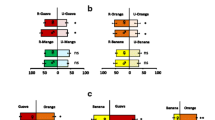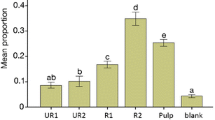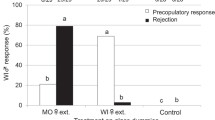Abstract
Extracts of 22 fruits were tested for their attractancy toAnastrepha suspensa (Loew), the Caribbean fruit fly. Box-orange, calamondin, carambola, cattley guava, loquat, and Surinam-cherry were about equal in attractiveness to males and females. Nine synthetic chemicals, including four found in box-orange ripe seed, were attractive to females. Five synthetic chemicals, including two in box-orange ripe seed, were attractive to males. Farnesol,α-phellandrene, and 3-carene were highest in attractiveness to both males and females. Females were more attracted than males to 12 synthetic chemicals. These data suggest that host chemicals serve as attractants and that female and male specific attractants and traps could be developed from host kairomone data. These data also suggest that the volatilization of chemicals from water may play an important role in kairomone biology.
Similar content being viewed by others
References
Barros, M.D., Do Amaral, P.M., andMalavasi, A. 1991. Comparison of glass and plastic MacPhail traps in the capture of the South American fruit fly,Anastrepha fraterculus (Diptera: Tephritidae) in Brazil.Fla. Entomol. 74(3):467–468.
Battiste, M.A., Strekowski, L., Vanderbilt, D.P., Visnick, M., King, R.W., andNation, J.L. 1983. Anastrephin and epianastrephin, novel lactone components isolated from the sex pheromone blend of male Caribbean and Mexican fruit flies.Tetrahedron Lett. 24(26):2611–2614.
Burditt, A.K., Jr. 1982.Anastrepha suspensa (Loew) (Diptera: Tephritidae) McPhail traps for survey and detection.Fla. Entomol. 65(3):367–373.
Burditt, A.K., Jr., andMcGovern, T.P. 1979. Chemicals tested as attractants for the Caribbean fruit fly, 1972–78. U.S. Department of Agriculture, Science and Education Administration, Agricultural Reviews and Manuals, ARM-S-6/October 1979. pp. 1–47.
Burk, T. 1983. Behavioral ecology of mating in the Caribbean fruit fly,Anastrepha suspensa (Loew) (Diptera: Tephritidae).Fla. Entomol. 66(3):330–344.
Byers, J.A. 1992. Optimal fractionation and bioassay plans for isolation of synergistic chemicals: The substractive-combination method.J. Chem. Ecol. 18(9):1603–1621.
Chuman, T., Sivinski, J., Heath, R.R., Calkins, C.O., Tumlinson, J.H., Battiste, M.A., Wydra, R.L., Strekowski, L., andNation, J.L. 1988. Suspensolide, a new macrolide component of male Caribbean fruit fly (Anastrepha suspensa [Loew]) volatiles.Tetrahedron Lett. 29(50):6561–6564.
Davis, J.C., Agee, H.R., andChambers, D.L. 1984. Trap features that promote capture of the Caribbean fruit fly.J. Agric. Entomol. 1(3):236–248.
Fleming, T.H. 1993. Plant-visiting bats.Am. Sci. 81(5):460–467.
Glotfelty, D.E., Seiber, J.N., andLiljedahl, L.A. 1987. Pesticides in fog.Nature 325:602–605.
Greany, P.D., andRiherd, C. 1993. Preface: Caribbean fruit fly status, economic importance, and control (Diptera: Tephritidae).Fla. Entomol. 76:209–211.
Greany, P.D., Burditt, A.K., Jr., andChambers, D.L. 1982. Effectiveness of Jackson traps for fruit flies improved by addition of colored patterns. Scientific Notes.Fla. Entomol. 65(3):364–375.
Heath, R.R., andManukian, A. 1992. Development and evaluation of systems to collect volatile semiochemicals from insects and plants using a charcoal-infused system for air purification.J. Chem. Ecol. 18(7):1209–1226.
Heath, R.R., Landolt, P.J., Dueben, B.D., Murphy, R.E., andSchneider, R.E. 1992. Identification of male cabbage looper sex pheromone attractive to females.J. Chem. Ecol. 18(2):441–453.
Heath, R.R., Epsky, N.D., Landolt, P.J., andSivinski, J. 1993. Development of attractants for monitoring Caribbean fruit flies (Diptera: Tephritidae).Fla. Entomol. 76:233–244.
Jordon, L.S., Farmer, W.J., Goodin, J.R., andRay, B.E. 1970. Nonbiological detoxication of the s-triazine herbicides.Res. Rev. 32:267–286.
Joulain, D. 1993. Cryogenic vacuum trap** of scents from temperate and tropical flowers. Facts and figures, pp. 197–204,in R. Teranishi, R.G. Buttery, and H. Sugisawa (eds.). Bioactive Volatile Compounds from Plants. ACS Symposium Series 525, Chapter 14. American Chemical Society, Washington, D.C.
Kilzer, L., Scheunert, I., Geyer, H., Klein, W., andKorte, F. 1979. Laboratory screening of the volatilization rates of organic chemicals from water and soil.Chemosphere. 10:751–761.
Leuenberger, C., Ligocki, M.P., andPankow, J.F. 1985. Trace organic compounds in rain. 4. Identities, concentrations, and scavenging mechanisms for phenols in urban air and rain.Environ. Sci. Technol. 19:1053–1058.
Mackay, D., andLeinonen, P.J. 1975. Rate of evaporation of low-solubility contaminants from water bodies to atmosphere.Environ. Sci. Technol. 9(13):1178–1180.
Mackay, D., andWolkoff, A.W. 1973. Rate of evaporation of low-solubility contaminants from water bodies to atmosphere.Environ. Sci. Technol. 7(7):611–614.
Mackay, D., Shiu, W.Y., andSutherland, R.P. 1979. Determination of air-water Henry's law constants for hydrophobic pollutants.Environ. Sci. Technol. 13(3):333–337.
Metcalf, R.L., andMetcalf, E.R. 1992. Plant Kairomones in Insect Ecology and Control. Chapman and Hall, New York, p. 4.
Murlis, J., Elkington, J.S., andCardé, R.T. 1992. Odor plumes and how insects use them.Annu. Rev. Entomol. 37:505–532.
Nation, J.L. 1972. Courtship behavior and evidence for a sex attractant in the male Caribbean fruit fly,Anastrepha suspensa.Ann. Entomol. Soc. Am. 65(6):1365–1367.
Nation, J.L. 1975. The sex pheromone blend of Caribbean fruit fly males: Isolation biological activity, and partial chemical characterization.Environ. Entomol. 4(1):27–30.
Nation, J.L. 1983. Sex pheromone of the Caribbean fruit fly: Chemistry and field ecology, pp. 109–110,in J. Miyamoto and P.C. Kearney (eds.). IUPAC Pesticide Chemistry, Human Welfare and the Environment, Vol. 2. Pergammon Press, New York.
Nation, J.L. 1989. The role of pheromones in the mating system ofAnastrepha fruit flies, pp. 189–205,in A.S. Robinson and G. Hooper (eds.). Fruit Flies Their Biology, Natural Enemies and Control, Vol. 3A. Elsevier Science Publishers, Amsterdam.
Nation, J.L. 1990. Biology of pheromone release by male Caribbean fruit flies,Anastrepha suspensa (Diptera: Tephritidae).J. Chem. Ecol. 16(2):553–572.
Perdomo, A.J., Nation, J.L., andBaranowski, R.M. 1976. Attraction of female and male Caribbean fruit flies to food-baited and male-baited traps under field conditions.Environ. Entomol. 5(6):1208–1210.
Robacker, D.C., andHart, W.G. 1987. Electroantennograms of male and female Caribbean fruit flies (Diptera: Tephritidae) elicited by chemicals produced by males.Ann. Entomol. Soc. Am. 80(4):508–512.
Robacker, D.C., Garcia, J.A., andHart, W.G. 1990a. Attraction of a Laboratory Strain ofAnastrepha ludens (Diptera: Tephritidae) to the odor of fermented chapote fruit and to pheromones in laboratory experiments.Environ. Entomol. 19(2):403–408.
Robacker, D.C., Tarshis Moreno, A.M., Garcia, J.A., andFlath, R.A. 1990b. A novel attractant for Mexican fruit fly,Anastrepha ludens, from fermented host fruit.J. Chem. Ecol. 16(10):2799–2815.
Robacker, D.C., Warfield, W.C., andFlath, R.A. 1992. A four-component attractant for the Mexican fruit fly,Anastrepha suspensa (Diptera: Tephritidae), from host fruit.J. Chem. Ecol. 18(7):1239–1254.
Robacker, D.C., Warfield, W.C., andAlbach, R.F. 1993. Partial characterization and HPLC isolation of bacteria-produced attractants for the Mexican fruit fly,Anastrepha ludens.J. Chem. Ecol. 19(3):543–557.
Royer, L., andMcNeil, J.N. 1993. Effect of relative humidity conditions on responsiveness of European corn borer (Ostrinia nubilalis) males to female sex pheromone in a wind tunnel.J. Chem. Ecol. 19(1):61–69.
SAS Institute, Inc. 1989. SAS/STAT User's Guide, Version 6, 4th ed., Vol. 2, SAS Institute, Cary, North Carolina, 846 pp.
Sharp, J.L. 1987. Laboratory and field experiments to improve enzymatic casein hydrolysate as an arrestant and attractant for Caribbean fruit fly,Anastrepha suspensa (Loew) (Diptera: Tephritidae).Fla. Entomol. 67(4):575–577.
Sharp, J.L., andAshley, T.R. 1984. Chemicals tested as internal dye markers for the Caribbean fruit fly,Anastrepha suspensa (Loew) (Diptera: Tephritidae).Fla. Entomol. 67(4):575–577.
Sivinski, J. 1990. Colored spherical traps for capture of Caribbean fruit fly.Anastrepha suspensa.Fla. Entomol. 73(1):123–128.
Spencer, W.F., andCliath, M.M. 1973. Pesticide volatilization as related to water loss from soil.J. Environ. Qual. 2(2):284–289.
Surburg, M., Guentert, M., andHarder, H. 1993. Volatile compounds from flowers. Analytical and olfactory aspects, pp. 168–186,in R. Teranishi, R.G. Buttery, and H. Sugisawa (eds.). Bioactive Volatile Compounds from Plants. ACS Symposium Series 525, Chapter 13, American Chemical Society, Washington, D.C.
Swanson, S.W., andBaranowski, R.M. 1972. Host range and infestation by the Caribbean fruit fly,Anastrepha suspensa (Diptera: Tephritidae) in South Florida.Proc. Fla. State Hortic. Soc. 85:271–274.
Webb, J.C., Burk, T., andSivinski, J. 1983. Attraction of female Caribbean fruit flies,Anastrepha suspensa (Diptera: Tephritidae), to the presence of males and male-produced stimuli in field cages.Ann. Entomol. Soc. Am. 76(6):996–998.
Weems, H.V., Jr. 1965.Anastrepha suspensa (Loew) (Diptera: Tephritidae). Entomology Circular No. 38, Florida Department of Agriculture Division of Plant Industry, July 1965, 4 pp.
Weidenhamer, J.D., Macias, F.A., Fischer, N.H., andWilliamson, G.B. 1993. Just how insoluble are monoterpenes?J. Chem. Ecol. 19(8):1799–1807.
Witherell, P.C. 1982. Efficacy of two types of survey traps for Caribbean fruit fly,Anastrepha suspensa (Loew). Scientific notes.Fla. Entomol. 65(4):580–581.
Woodwell, G.M., Craig, P.P., andJohnson, H.A. 1971. DDT in the biosphere: Where does it go?Science 174:1101–1107.
Zobel, A.M., andBrown, S.A. 1988. Determination of furanocoumarins on the leaf surface ofRuta graveolens with an improved extraction technique.J. Nat. Prod. 51:941–946.
Zobel, A.M., andBrown, S.A. 1993. Influence of low-intensity ultraviolet radiation on extrusion of furanocoumarins to the leaf surface.J. Chem. Ecol. 19:939–952.
Author information
Authors and Affiliations
Rights and permissions
About this article
Cite this article
Nigg, H.N., Mallory, L.L., Simpson, S.E. et al. Caribbean fruit fly,Anastrepha suspensa (Loew), attraction to host fruit and host kairomones. J Chem Ecol 20, 727–743 (1994). https://doi.org/10.1007/BF02059609
Received:
Accepted:
Issue Date:
DOI: https://doi.org/10.1007/BF02059609




